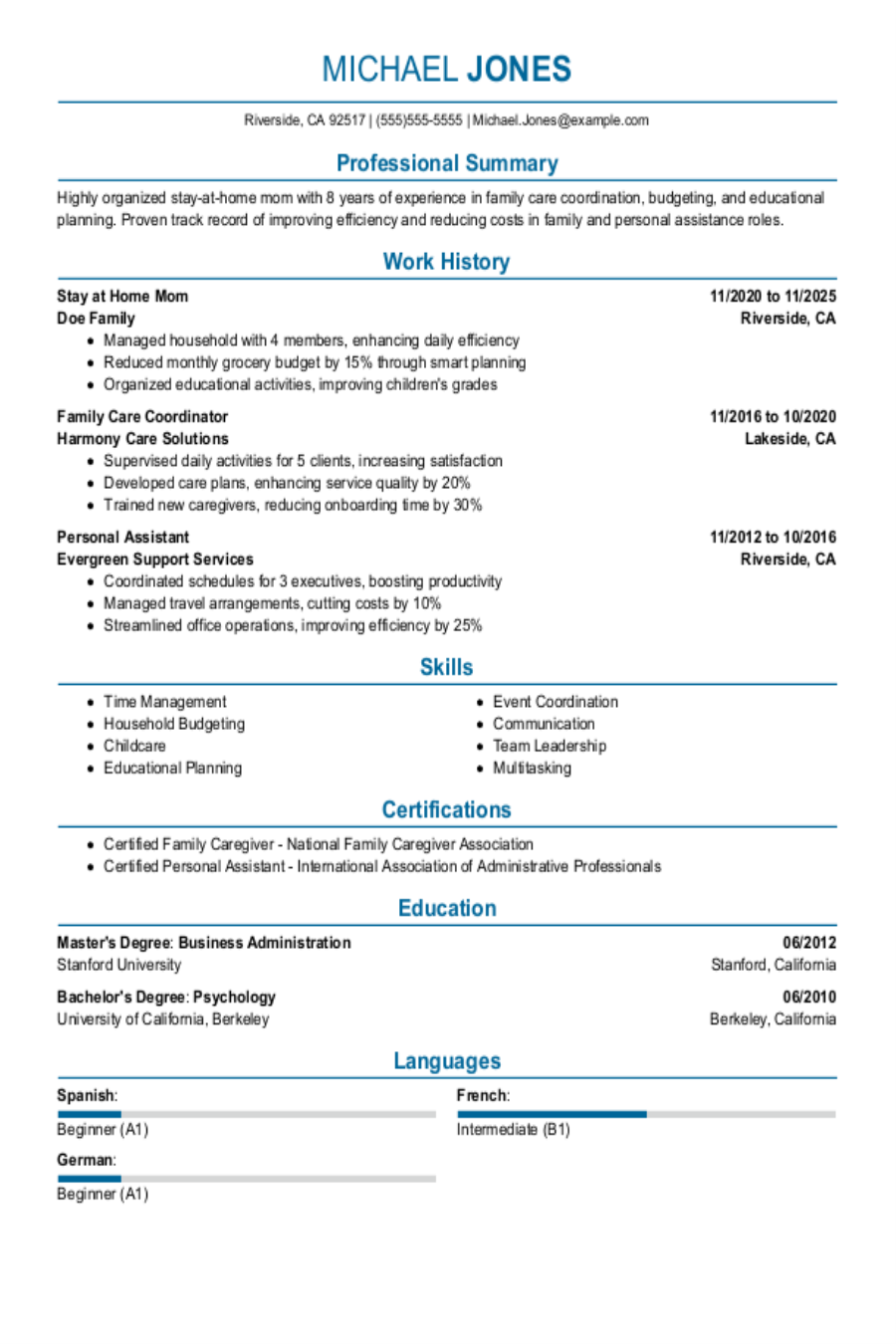Popular Pharmacist Resume Examples
Entry-level pharmacist resume
An entry-level resume for a pharmacist should focus on relevant education, internships, certifications, and essential skills like patient care, medication management, and strong communication abilities to stand out.
Prioritizes readability: A simple resume template highlights your expertise in pharmaceutical care, ensuring recruiters quickly recognize key qualifications and achievements like improving patient satisfaction and reducing medication errors.
Showcases education: This resume starts with education, helping the candidate’s degrees serve as a foundation for their professional expertise.
Mid-career pharmacist resume
A mid-career pharmacist resume should emphasize a combination of clinical expertise, patient management skills, and continuous professional development to effectively demonstrate their value to potential employers.
Encourages quick scanning: A well-structured format and clear design highlight a pharmacist's qualifications, making it easy for hiring managers to quickly identify relevant skills and achievements.
Employs active language: Using action verbs such as "increased," "managed," and "optimized" can highlight initiative and effectiveness, showcasing a pharmacist's ability to improve patient care and operational efficiency.
Experienced pharmacist resume
An experienced pharmacist resume should emphasize relevant clinical experience and key achievements to clearly illustrate professional growth and expertise in the field.
Follows traditional format: The chronological resume format effectively highlights the extensive experience of the job seeker, making it easy for readers to follow their career advancements and significant contributions in various pharmacy roles.
Highlights experience: The resume's opening summary effectively emphasizes over 11 years of experience in pharmaceutical roles, showcasing a commitment to patient care and operational excellence.
No experience pharmacist resume
A resume for an applicant with no experience should highlight relevant coursework, certifications, and volunteer work to showcase the applicant's knowledge and commitment to the profession.
Emphasizes professional skills: Highlighting essential skills in pharmaceutical knowledge and patient communication illustrates the job seeker's preparedness for a pharmacist role, despite their limited professional experience.
Avoids jargon: Job seekers often feel the need to embellish basic responsibilities with complex terminology to make their experience appear more impressive. However, this resume's straightforward and honest approach is much more effective in communicating qualifications.
More resume examples
Pharmacist Resume Template
Looking to create an effective application? Use this pharmacist resume template as a foundation—simply tailor it with your personal details and achievements for a standout presentation.
Aya Johnson
Greenfield, IN 46147
(555)555-5555
Aya.Johnson@example.com
Professional Summary
Experienced pharmacist with 9 years in medication management. Proven success in optimizing inventory and enhancing patient care, with a strong track record in team leadership and clinical research.
Work History
Pharmacist
Pioneer Pharmacy Solutions - Greenfield, IN
June 2020 - October 2025
- Managed medication distribution, reducing errors by 20%
- Increased patient counseling sessions by 30% monthly
- Optimized inventory, saving $15,000 annually
Clinical Pharmacy Specialist
Urban Health Center - Indianapolis, IN
June 2015 - May 2020
- Developed drug protocols, improving adherence by 25%
- Mentored 5 junior pharmacists yearly
- Coordinated therapy plans, enhancing outcomes by 15%
Pharmacy Technician
Healthcare Plus Pharmacies - Greenfield, IN
June 2012 - May 2015
- Assisted in dispensing, ensuring 98% accuracy
- Maintained stock records, reducing shortages by 10%
- Performed patient verification, increasing safety
Skills
- Medication Management
- Patient Counseling
- Inventory Optimization
- Pharmaceutical Care
- Clinical Research
- Regulatory Compliance
- Pharmacovigilance
- Team Leadership
Education
Master of Science Pharmacy
University of Illinois at Chicago Chicago, Illinois
May 2012
Bachelor of Science Pharmaceutical Sciences
Illinois State University Normal, Illinois
May 2009
Certifications
- Certified Pharmacy Technician (CPhT) - Pharmacy Technician Certification Board
- Board Certified Pharmacotherapy Specialist (BCPS) - Board of Pharmacy Specialties
- Immunization Delivery Certification - American Pharmacists Association
Languages
- Spanish - Beginner (A1)
- French - Intermediate (B1)
- German - Beginner (A1)
Must-Have Skills on a Pharmacist Resume
A strong skills section is important for making your pharmacist resume stand out.
Healthcare and medical professionals make a direct impact on individual and community well-being. The skills you highlight should reflect your ability to deliver dependable support and uphold high standards. Your resume is a chance to show how you contribute meaningfully to quality care and positive outcomes.
We've analyzed the most common hard and soft skills for pharmacists using data from Resume Now’s internal records.
When you're ready to improve your resume, try our AI Resume Skills Generator. It provides tailored suggestions based on your job title, ensuring you highlight both technical expertise and interpersonal abilities.
Writing Your Pharmacist Resume
Having explored these effective resume examples, you are now prepared to delve into the process of crafting your own resume. We will guide you through each section step by step, ensuring you understand how to write a resume that stands out.
List your most relevant skills
An effective skills section for your pharmacist resume should focus on including both technical abilities, like medication management and patient counseling, as well as essential soft skills such as attention to detail and communication.
It's important to tailor your skills section to match keywords from the job listing. This strategy helps you stand out to human recruiters while also optimizing your resume for applicant tracking systems (ATS). Highlighting terms related to pharmacy practice ensures that both audiences see you as a fitting applicant who meets their specific needs.
Example of skills on a pharmacist resume
- Knowledgeable in medication management and patient counseling
- Proficient in using pharmacy software for accurate prescription processing
- Strong communicator with a focus on patient education and safety
- Capable of collaborating effectively within healthcare teams
A compelling skills section is essential for showcasing your readiness for the pharmacist position. It should effectively combine the technical skills specified in the job description with important soft skills, illustrating your comprehensive preparation to meet the role's demands. This shows employers that you are well-equipped to excel in their pharmacy setting.
Highlight your work history
Your work experience section needs to demonstrate how you've applied your skills in diverse settings can showcase the value you bring to potential employers. By focusing on specific accomplishments, you can set yourself apart from other job seekers.
For each job entry, include essential details like your title, the employer's name, and employment dates. This approach not only establishes professional credibility but also allows hiring managers to assess your background and pharmacy practice experience quickly. Incorporate any relevant certifications or specialized training that could improve your appeal as a job seeker.
Example of a pharmacist work experience entry
- Pharmacist
HealthPlus Pharmacy - Dallas, TX
June 2019 - Present - Dispense over 150 prescriptions daily while ensuring compliance with state and federal regulations, achieving a 99% accuracy rate in medication dispensing
- Provide personalized patient consultations to educate on proper medication usage and potential side effects, improving patient adherence by 30%
- Collaborate with healthcare providers to develop customized medication plans for patients with chronic conditions, improving overall health outcomes
- Mentor and supervise pharmacy interns in clinical practices and customer service skills, contributing to a 25% increase in team efficiency
- Implement inventory management strategies that reduced medication waste by 15%, optimizing the pharmacy's operational costs
Quantifying achievements as a pharmacist is essential to illustrate the impact of your contributions. For example, stating that you reduced medication error rates by 40% through rigorous patient counseling not only highlights your effectiveness but also builds trust with potential employers.
Include your education
The education section of your pharmacist resume should feature your degrees and diplomas listed in reverse-chronological order, starting with the most recent. Include your Doctor of Pharmacy (Pharm.D.) and any additional relevant qualifications while excluding your high school diploma if you possess a higher degree.
For those currently studying or with incomplete degrees, it is important to indicate your highest level of education achieved along with an expected graduation date. Consider adding bullet points to showcase relevant coursework or significant academic achievements that relate directly to pharmacy practice.
Common certifications for a pharmacist resume
- Doctor of Pharmacy (Pharm.D.) – Accreditation Council for Pharmacy Education (ACPE)
- Board Certified Pharmacotherapy Specialist (BCPS) – The Board of Pharmaceutical Specialties (BPS)
- Certified Diabetes Educator (CDE) – National Certification Board for Diabetes Educators (NCBDE)
- Medication Therapy Management Certification (MTM-Cert) – Academy of Managed Care Pharmacy (AMCP)
Sum up your resume with an introduction
Creating a compelling profile section on your resume is important, as it sets the tone for your candidacy. This section acts as your introduction, allowing you to showcase your professional identity and what makes you unique.
For seasoned pharmacists, using a professional summary is often the most effective approach. This format allows you to highlight key achievements, certifications, and relevant experiences right at the top of your resume. If you have little experience, create a resume objective centered on your professional development goals.
Professional summary example
Dedicated pharmacist with over 5 years of experience in retail and clinical settings. Demonstrated success in optimizing medication management, improving patient care, and collaborating effectively with healthcare teams. Expert in pharmaceutical counseling, drug utilization review, and ensuring compliance with regulatory standards.
Resume objective example
Enthusiastic pharmacist eager to apply strong communication, attention to detail, and medication management skills within a collaborative healthcare environment. Committed to improving patient care and promoting health awareness while supporting the pharmacy team in delivering exceptional service.
When crafting your resume profile for a pharmacist position, seize the chance to include relevant keywords. This section is the first impression you make on hiring managers and ATS systems. Carefully analyze job descriptions and weave in essential qualifications to improve your visibility and increase your chances of landing an interview.
Add unique sections to set you apart
Optional resume sections can effectively highlight your distinct qualifications as a pharmacist. These areas allow you to present skills and experiences that set you apart from other job seekers.
Including relevant hobbies or volunteer work in your resume can offer insight into your professional identity. For instance, if you participate in community health initiatives, it demonstrates your commitment to improving public health.
Three sections perfect for a pharmacist resume
- Languages: As a pharmacist, you frequently interact with patients and healthcare providers. Including your language skills on your resume can improve communication, ensuring accurate medication guidance for diverse populations.
- Volunteer Work: Including volunteer work on a resume showcases your dedication to helping others while improving skills like teamwork and leadership. It tells employers you're committed not only to your career but also to your community.
- Accomplishments: As a pharmacist, quantifiable accomplishments highlight your contributions to patient care and safety. Present these achievements within your work experience section or consider adding a distinct accomplishments section to emphasize them.
5 Resume Formatting Tips
- Choose a format that matches your career stage.
Choosing the right resume format is important for showcasing your experience. If you're an experienced pharmacist, a chronological format effectively highlights your career progression. For those just starting, a functional resume emphasizes skills over work history. Consider a combination format to present both skills and experience clearly.
- Pick a smart resume template.
Choosing a professional resume template can improve readability and streamline formatting. This choice allows your key achievements to stand out effectively. If you decide against using a template, ensure that your layout remains straightforward with clear headings and an ATS-friendly font for optimal visibility.
- Select an appropriate font.
Opt for a clean and professional font to improve resume readability. Fonts like Helvetica, Georgia, or Verdana are excellent choices because they make your information clear and accessible to both ATS and hiring managers.
- Use consistent formatting.
Align your resume to the left and maintain equal margins on all sides to ensure a polished and professional look that captures attention.
- Keep your resume to one or two pages.
When crafting your resume, remember that resumes should be one page long. If you have extensive experience, a two-page resume can still be acceptable. Keep your content concise and focus on what truly highlights your qualifications.
What’s the Average Pharmacist Salary?
Pharmacist salaries vary based on location, career level, and qualifications.
This data, provided by the Bureau of Labor Statistics, will show you expected salary ranges for pharmacists in the top 5 highest-paying states, including the District of Columbia. The figures reflect the most current salary data available, collected in 2024.
- Full Range
- Most Common (25th–75th percentile)
- Average
California
Most common: $137,540 - $197,000
Alaska
Most common: $146,550 - $174,010
Oregon
Most common: $141,420 - $179,280
Washington
Most common: $139,020 - $174,810
Minnesota
Most common: $135,290 - $165,360
Tools for Your Job Search
Are you preparing to apply for that coveted pharmacist role? Before you submit your application, consider using our ATS Resume Checker. This tool provides valuable insights on how your resume performs against the automated systems used by many pharmacies and healthcare facilities for initial applicant screening.
In search of a powerful ally in your job application process? Our AI Resume Builder offers personalized content recommendations tailored specifically to your pharmaceutical background. With professionally crafted templates, it ensures that your clinical experience and qualifications stand out to hiring managers.
Frequently Asked Questions
Last Updated: November 3, 2025
Absolutely. A cover letter is important as it adds depth to your resume and provides an opportunity to engage directly with potential employers. It's your moment to express passion for the pharmacist role and highlight how your unique skills make you a great fit. So don’t hesitate—write a cover letter that showcases your qualifications!
For a seamless experience, consider using our AI Cover Letter Generator, which allows you to create a personalized, job-winning cover letter in minutes. Plus, you'll have access to various cover letter template options that perfectly complement your resume, ensuring a polished and professional presentation of your application.
A resume is typically concise, ranging from one to two pages, while a curriculum vitae (CV) can extend several pages and includes in-depth details about your academic background, research accomplishments, publications, and professional experiences. The CV templates available online are ideal for capturing these comprehensive details and showcasing extensive qualifications.
You should use a CV when applying for specialized positions in academia, healthcare, or certain legal fields. If you're unsure whether you need a CV or want to create one quickly, our online CV Maker offers a simple solution! With various tailored designs crafted for different industries and career levels, you can effortlessly put together a stunning CV that meets your needs.
To write a strong CV, focus on structuring your document with clear sections like education, work experience, skills, and certifications. Use professional templates that are both visually appealing and compatible with applicant tracking systems. Tailor your CV for each job application by integrating relevant keywords from the job description to emphasize your suitability.
Furthermore, reviewing CV examples from industry professionals can offer valuable insights into effective presentation and formatting. Identify standout features in these examples that resonate with your experience and style. This approach can help you craft a compelling CV that captures attention.
When addressing gaps on your resume, be honest about the reasons behind them. Explain what you were doing during that time, whether it was furthering your education or volunteering. Highlight these experiences to show potential employers that you remained proactive and engaged. Then, smoothly transition back to presenting your qualifications and relevant experience, reinforcing your fit for the role.
To build an effective skills section as a pharmacist, combine your technical competencies, such as medication management and pharmaceutical software skill, with vital soft skills like communication and empathy. Illustrate how you've applied these skills in your experience to improve patient care and improve pharmacy operations.
To improve your pharmacist resume, focus on tailoring its content to highlight the essential skills needed for each specific job. Review the job listing carefully and extract relevant keywords that reflect your experience and qualifications. Incorporating these terms will demonstrate your suitability for the position.
Was this information helpful? Let us know!
Hailey is a career advice writer dedicated to helping job seekers excel in their careers.
More resources

What if I Don't Have Professional References?
Access advice on what to do if you get to the reference check ...
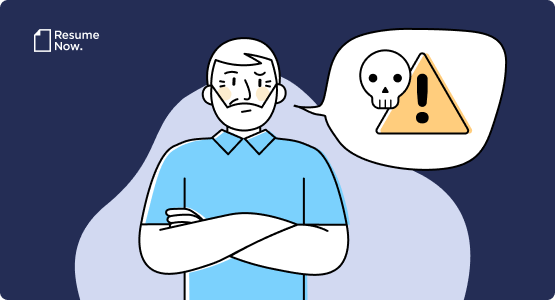
The Most Dangerous Jobs in America: Some Pay Less Than $40K, Others Top $190K
Resume Now s report reveals the highest and lowest paying dang...
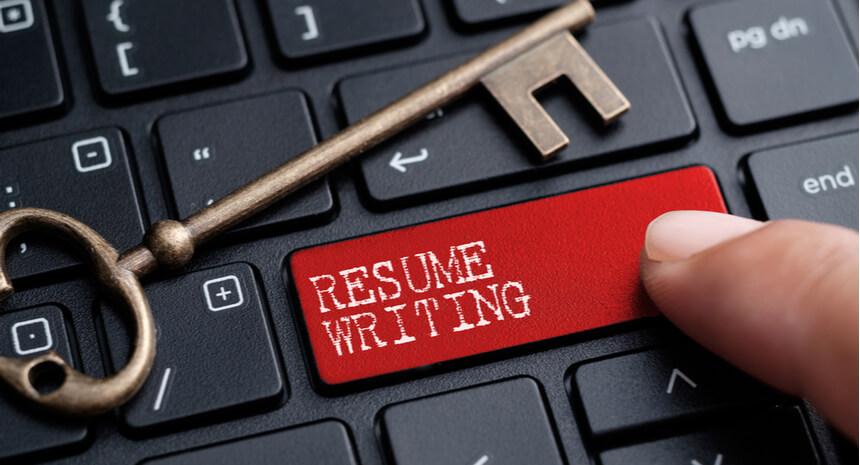
How to Write a Resume: Guide & Examples for 2025
If you re wondering how to write a resume that grabs attenti...
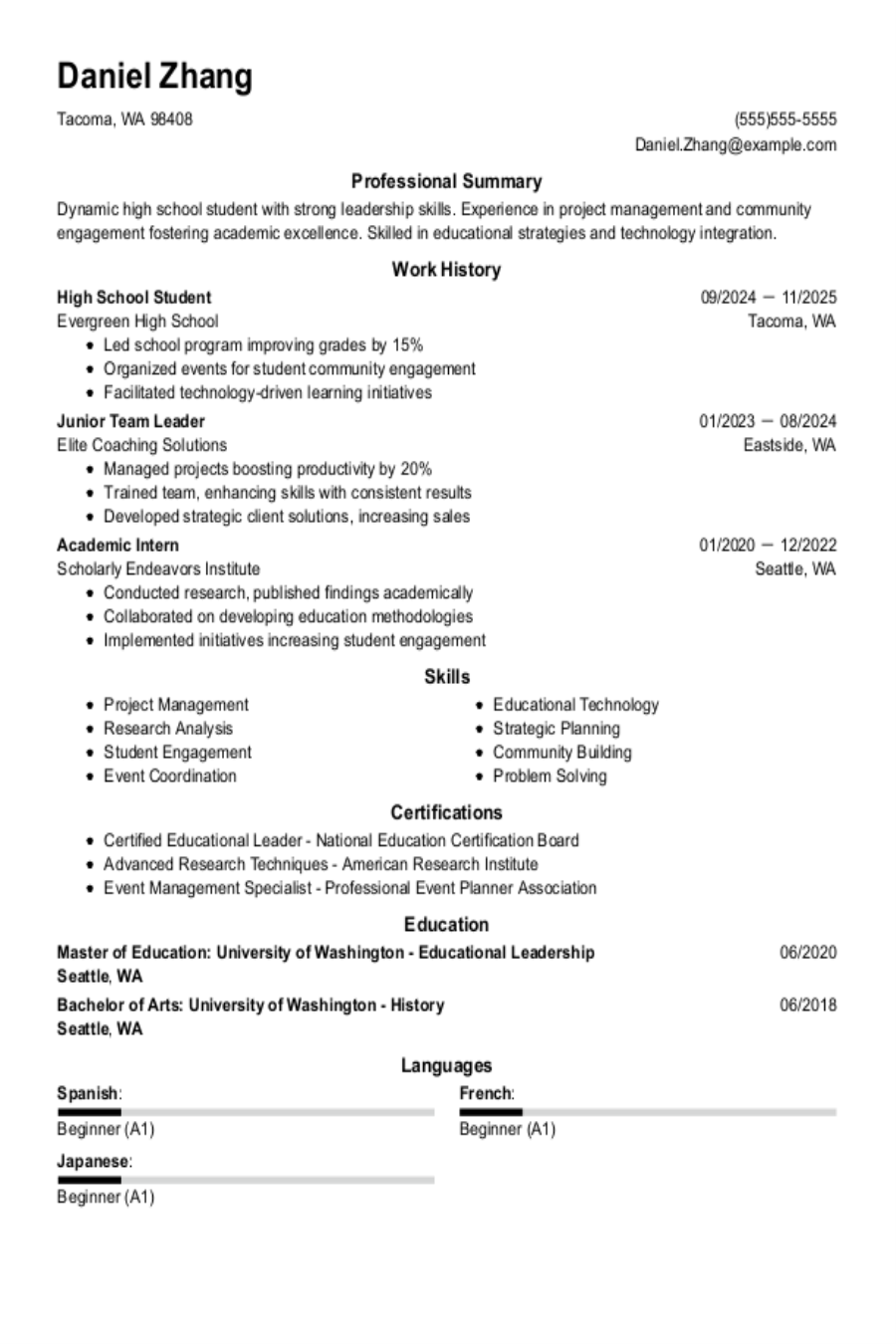
Student Resume: 2025 Examples & Templates
Check out our guide for help writing a job-winning student res...
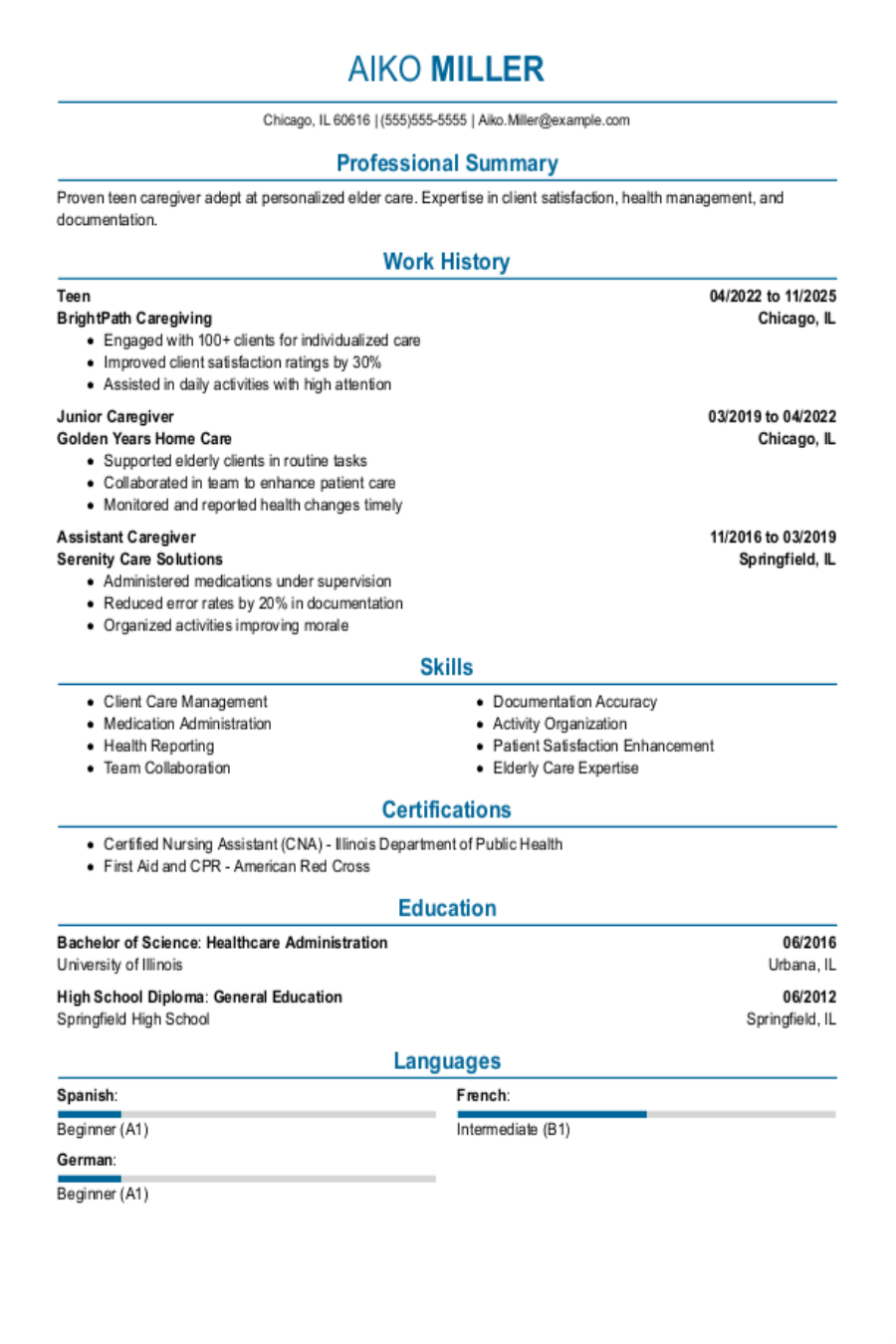
Teen Resume: Examples, Template & Advice for Beginners
Whether you re looking for an internship or your first job a ...


